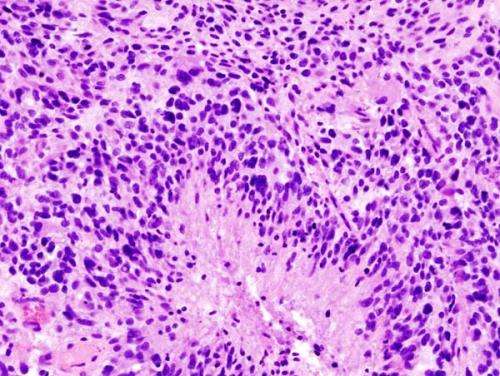Glioblastoma 'ecosystem' redefined for more effective immunotherapy trials

A research team has revealed the intrinsic gene expression patterns of glioblastoma (GBM) tumors, insights that could drive more effective treatments for GBM, the most common and deadly malignant primary brain tumors in adults.
Jackson Laboratory (JAX) Professor Roel Verhaak, Ph.D., is the senior author of a paper published in Cancer Cell showing tumor gene expression patterns distinct from those of the surrounding immune cells, and characterizing the effects of chemotherapy and radiation treatments.
Verhaak was the first author of a landmark 2010 paper in Cancer Cell that established four subclasses of GBM—proneural, mesenchymal, neural and classical—based on molecular markers found in patient tumors. That paper has been widely influential in the research world, yet, observes Verhaak, "these four subtypes have not translated into differential treatment strategies. Every glioblastoma patient receives essentially the same treatment. We hope that our latest work will improve understanding of how to optimally stratify patients, another step towards precision medicine and more targeted, effective treatments."
The cells that surround a tumor are known as its microenvironment, usually consisting of immune cells, supporting cells and other normal cells. Tumors donated to tissue banks consist of a mixture of microenvironment cells, cancer cells and the surgeon's narrow margin of safety to ensure the removal of cancerous tissue while avoiding damaging essential brain functions.
In the new paper, the research team isolated the intrinsic gene expression of GBM tumors from the contributions by the tumor microenvironment, and observed the impact by the standard cancer treatment regimens of temozolomide and radiation on that expression, as well as subtracting out the effects of therapy on the tumor-associated non-cancer cells.
"By separating out the contributions of the microenvironment, we developed a much clearer picture of the 'ecosystem' of hundreds of tumors," Verhaak says. "We determined what types of cells are in the microenvironment and what their contributions are, and also assessed how treatment affects the microenvironment as well as the tumor cells themselves."
(Through this approach, the researchers found that the molecular markers defining the neural subtype of GBM could be ascsribed to the presence of normal neural tissue in the tumor margin, thus not representing a true subtype.)
By studying gene expression patterns in glioblastomas after treatment, their analysis also revealed that the presence of macrophages correlates with poorer outcomes for GBM patients receiving radiation therapy, and that tumors with a relatively high number of point mutations have an increased number of positive T cells, indicating they could respond to a kind of immunotherapy known as checkpoint inhibitors.
The resulting gene expression datasets, which are publicly available to researchers, provide comprehensive profiles of glioblastoma characteristics to more accurately guide immunotherapy trials.
More information: Wang et al.: Tumor evolution of glioma intrinsic gene expression subtype associates with immunological changes in the microenvironment. Cancer Cell, DOI: 10.1016/j.ccell.2017.06.003

















